
| 
| 
CLICK ON HER PICTURE TO GO TO 'HELEN KELLER WORLDWIDE'
"Alone we can do so little;
together we can do so much."
-Helen Keller
The Miracle
Helen Keller
She altered our perception of the disabled and remapped the boundaries of sight and sense
BY DIANE SCHUUR WITH DAVID JACKSON
Helen Keller was less than two years old when she came down with a fever. It struck dramatically and left her unconscious. The fever went just as suddenly. But she was blinded and, very soon after, deaf. As she grew up, she managed to learn to do tiny errands, but she also realized that she was missing something. "Sometimes," she later wrote, "I stood between two persons who were conversing and touched their lips. I could not understand, and was vexed. I moved my lips and gesticulated frantically without result. This made me so angry at times that I kicked and screamed until I was exhausted." She was a wild child.
I can understand her rage. I was born two months prematurely and was placed in an incubator. The practice at the time was to pump a large amount of oxygen into the incubator, something doctors have since learned to be extremely cautious about. But as a result, I lost my sight. I was sent to a state school for the blind, but I flunked first grade because Braille just didn't make any sense to me. Words were a weird concept. I remember being hit and slapped. And you act all that in. All rage is anger that is acted in, bottled in for so long that it just pops out. Helen had it harder. She was both blind and deaf. But, oh, the transformation that came over her when she discovered that words were related to things! It's like the lyrics of that song: "On a clear day, rise and look around you, and you'll see who you are."
I can say the word see. I can speak the language of the sighted. That's part of the first great achievement of Helen Keller. She proved how language could liberate the blind and the deaf. She wrote, "Literature is my utopia. Here I am not disenfranchised." But how she struggled to master language. In her book "Midstream," she wrote about how she was frustrated by the alphabet, by the language of the deaf, even with the speed with which her teacher spelled things out for her on her palm. She was impatient and hungry for words, and her teacher's scribbling on her hand would never be as fast, she thought, as the people who could read the words with their eyes. I remember how books got me going after I finally grasped Braille. Being in that school was like being in an orphanage. But words--and in my case, music--changed that isolation. With language, Keller, who could not hear and could not see, proved she could communicate in the world of sight and sound--and was able to speak to it and live in it. I am a beneficiary of her work. Because of her example, the world has given way a little. In my case, I was able to go from the state school for the blind to regular public school from the age of 11 until my senior year in high school. And then I decided on my own to go back into the school for the blind. Now I sing jazz.
As miraculous as learning language may seem, that achievement of Keller's belongs to the 19th century. It was also a co-production with her patient and persevering teacher, Anne Sullivan. Helen Keller's greater achievement came after Sullivan, her companion and protector, died in 1936. Keller would live 32 more years and in that time would prove that the disabled can be independent. I hate the word handicapped. Keller would too. We are people with inconveniences. We're not charity cases. She was once asked how disabled veterans of World War II should be treated and said that they do "not want to be treated as heroes. They want to be able to live naturally and to be treated as human beings."
Those people whose only experience of her is "The Miracle Worker" will be surprised to discover her many dimensions. "My work for the blind," she wrote, "has never occupied a center in my personality. My sympathies are with all who struggle for justice." She was a tireless activist for racial and sexual equality. She once said, "I think God made woman foolish so that she might be a suitable companion to man." She had such left-leaning opinions that the FBI under J. Edgar Hoover kept a file on her. And who were her choices for the most important people of the century? Thomas Edison, Charlie Chaplin and Lenin. Furthermore, she did not think appearing on the vaudeville circuit, showing off her skills, was beneath her, even as her friends were shocked that she would venture onto the vulgar stage. She was complex. Her main message was and is, "We're like everybody else. We're here to be able to live a life as full as any sighted person's. And it's O.K. to be ourselves."
That means we have the freedom to be as extraordinary as the sighted. Keller loved an audience and wrote that she adored "the warm tide of human life pulsing round and round me." That's why the stage appealed to her, why she learned to speak and to deliver speeches. And to feel the vibrations of music, of the radio, of the movement of lips. You must understand that even more than sighted people, we need to be touched. When you look at a person, eye to eye, I imagine it's like touching them. We don't have that convenience. But when I perform, I get that experience from a crowd. Helen Keller must have as well. She was our first star. And I am very grateful to her.
BORN June 27, 1880, in Tuscumbia, Ala.
1882 At 19 months old, has a high fever and becomes deaf and blind
1887 Anne Sullivan becomes Keller's tutor
1903 "The Story of My Life" is published
1919 Begins four-year stretch appearing with Sullivan in vaudeville shows
1936 Sullivan dies
1959 "The Miracle Worker" airs on television. It is later adapted for the stage and film
DIED June 1, 1968, in Westport, Conn.
(Source : www.time.com)
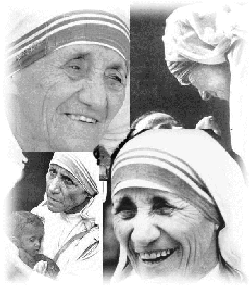
CLICK ON THE PICTURE TO GO TO
MOTHER TERESA , THE OFFICIAL WEBSITE
Mother Teresa of Calcutta was a Roman Catholic nun and founder of the Missionaries of Charity. In 1979, for her humanitarian work, she was awarded the most prestigious prize in the world, the Nobel Peace Prize. Her labor made her so worthy that, in reality, she gave honor to the prize, rather than the other way around!
Agnes Gonxha Bojaxhiu was born in 1910 to Albanian parents in Skopje, which at the time was under the rule of the Ottoman Empire. (The city is now the capital of the Former Yugoslav Republic of Macedonia.) When she was 18, she entered the Order of the Sisters of Our Lady of Loreto in Ireland. She trained in Dublin and in Darjeeling, India, before taking her religious vows in 1937. She took the name Teresa from Saint Teresa of Lisieux , the patron saint of foreign missionaries.
In September 1946, while riding in a train from Calcutta to Darjeeling to engage in 8 days of spiritual exercises, she received a divine calling from God "to serve Him amongst the poorest of the poor".
She served as principal of a Roman Catholic high school in Calcutta, and was moved by the presence of the sick and dying on the city's streets. In 1948 she was granted permission to leave her post at the convent and begin a ministry among the sick. That same year she became an Indian citizen.
In 1950 Mother Teresa and her associates were approved within the archdiocese of Calcutta as the Missionaries of Charity. The order was later recognized as a pontifical congregation under the jurisdiction of Rome. Members of the congregation take four vows on acceptance by the religious community. In addition to the three basic vows of poverty, chastity, and obedience, a fourth vow is required pledging service to the poor, whom Mother Teresa described as the embodiment of Christ.
In 1952 Mother Teresa opened the Nirmal Hriday (Pure Heart) Home for Dying Destitutes in Calcutta. She and her fellow nuns took in dying Indians off the streets of Calcutta and brought them to this home to care for them during the days before they died, so that they might be able to die in peace and with dignity.
In serving the people abandoned by society, Mother Teresa put love into action. Her spirit of giving inspired many to follow her, and her work eventually expanded to many other parts of the world. Today over 5000 sisters, brothers, and volunteers run approximately 500 centers worldwide, feeding 500,000 families and helping 90,000 lepers every year.
In recognition of her efforts, Mother Teresa was bestowed many awards, including the Padma Shri award for distinguished service in 1962, The Pope John XXIII Peace Prize in 1971, the Nobel Peace Prize in 1979, the Presidential Medal of Freedom in 1985, and the Congressional Gold Medal in 1997. Mother Teresa accepted all awards on behalf of the poor, using any money that accompanied them to fund her centers.
Mother Teresa was forced to scale back her activities in 1990 because of declining health. On March 13 1997, she stepped down as head of the order and Sister Nirmala was chosen to succeed her as leader of the Missionaries of Charity.
On September 5, 1997, at the age of 87, the best loved woman of the century passed away. Her funeral service was on September 13, 1997, the 51st anniversary of her receiving her divine mission from God.
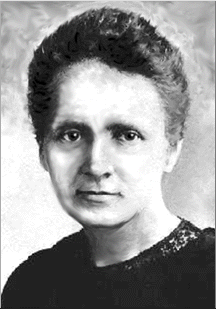
CLICK ON THE PICTURE TO GO TO MARIE CURIE CANCER CARE WEBSITE
Marie Sklodowska Curie
Physicist
1867-1934
You cannot hope to build a better world without improving the individuals.
To that end, each of us must work for our own improvement and, at the same
time, share a general responsibility for all humanity, our particular duty being
to aid those to whom we think we can be most useful.
Maria Sklodowska (sklaw DAWF skah) was born November 7, 1867 in Warsaw, Poland. She would become famous for her research into radioactivity, and was the first woman to win a Nobel prize.
Marie Curie grew up in a family that valued education. As a young woman she went to Paris to study mathematics, chemistry and physics. She began studying at the Sorbonne in 1891, and was the first woman to teach there. She adopted the French spelling of her name (Marie) and also met Pierre Curie, who taught physics at University of Paris. Marie and Pierre soon married, and teamed up to conduct research on radioactive substances. They found that the uranium ore, or pitchblende, contained much more radioactivity than could be explained solely by the uranium content.
The Curie's began a search for the source of the radioactivity and discovered two highly radioactive elements, "radium" and "polonium." The Curie's won the 1903 Nobel prize for physics for their discovery. They shared the award with another French physicist, Antoine Henri Bacquerel, who had discovered natural radioactivity. In 1906 Pierre, overworked and weakened by his prolonged exposure to radiation, died when he was run over by a car.
Madame Curie continued her work on radioactive elements and won the 1911 Nobel prize for chemistry for isolating radium and studying its chemical properties. In 1914 she helped found the Radium Institute in Paris, and was the Institute's first director. When the first world war broke out, Madame Curie thought X-rays would help to locate bullets and facilitate surgery. It was also important not to move the wounded, so she invented X-ray vans and trained 150 female attendants.
On July 4, 1934, at the age of 67 Madame Curie died of leukemia (aplastic pernicious anemia), thought to have been brought on by exposure to the high levels of radiation involved in her research. After her death the Radium Institute was rename the Curie Institute in her honor.
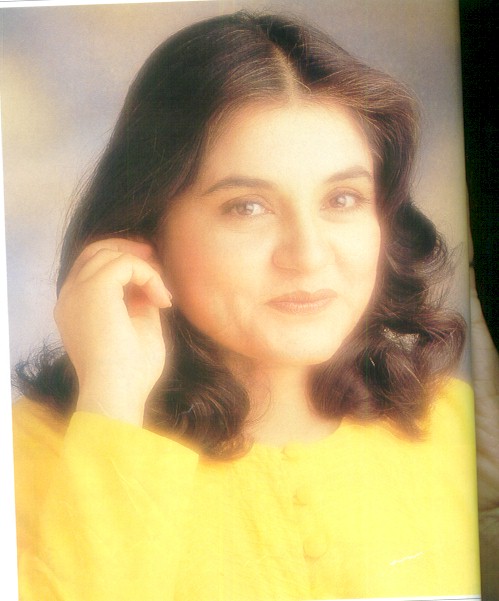
MANEKA GANDHI
SHE HAS CONTRIBUTED MORE TOWARDS ANIMAL WELFARE THAN ANY OTHER PERSON!
(CLICK ON THE PICTURE TO GO TO THE 'PEOPLE FOR ANIMALS' WEBSITE)
Educational Qualifications : I.S.C.
Educated at Lawrence School, Sanawar
(Himachal Pradesh)
Profession :
Writer, Animal Activist and Environmentalist
Permanent Address :
A-4, Maharani Bagh, New Delhi-110065.
Positions Held :
1988-89 General Secretary, J.D.
1989 Elected to Lok Sabha (Ninth)
1989-91 Union Minister, Environment and Forests
1996 Re-elected to Lok Sabha (Eleventh)
1998 Elected to Lok Sabha (Twelfth) for the third time
Books Published:
(i) 'Sanjay Gandhi', (ii) 'Stories for Children'
(iii) '1001 Animal Quiz', (iv) 'Penguin Book of Hindu Names',
(v) `Complete Book of Parsi and Muslim Names'
(vi) `Brahma's Hair', (vii) `Heads and Tails',
(viii) `Animal Laws of India' and (ix) `First Aid for Animals'
Literary, Artistic and Scientific Accomplishments :
Publisher/author of Definitive Etymological Works; Plant Mythology;
Animal activism and laws; Editor of political monthly magazine,
'Surya', 1976-80; Widely read columnist writing on animal welfare
and environment; creator and presenter of weekly T.V. shows on
animals and environment in English and Hindi
Social and Cultural Activities:
Founder Member of People for Animals; Patron, Worldwide
Fund for Nature (WWF); Chairperson, RUGMARK and Delhi Society
for Prevention of Cruelty to Animals (DSPCA); Managing-Trustee,
Ruth Cowell Foundation (animal care shelter and hospital)
Special Interests :
Writing, animal welfare, environmental protection and the
study of law
Favourite Pastime and Recreation:
Reading and gardening
Countries Visited :
Widely travelled
Other Information :
Recipient of the prestigious (i) Lord Erskine Award from
the RSPCA; (ii) 'Prani Mitra Award', 1996; and (iii) "Maharana
Mewar, Foundation Award" 1996 for Environmental work;
Environmentalist and Vegetarian of the year 1994;
Delivered the Schumacher Address in U.K., 1995; Key-note
Speaker at the National Alliance for Animals in Washington, 1996
(Source : www.indianembassy.org)
MORE INFO
Father's Name Lt. Col. T.S. Anand
Date of Birth 26 August 1956
Place of Birth New Delhi
Marital Status Widow
Date of Marriage 29 September 1974)
Spouse's Name Late Shri Sanjay Gandhi
No. of Sons One
Educational I.S.C.
Qualifications Educated at Lawrence School, Sanawar (Himachal Pradesh)
Profession Writer, Animal Activist and Environmentalist
Permanent Address A-4, Maharani Bagh,
New Delhi-110065.
Tel. (011) 6840402, 6824803
Fax. (011) 6823144
Positions Held
1988-89 General-Secretary, Janata Dal (J.D.)
1989 Elected to 9th Lok Sabha
1989-91 Union Minister of State, Environment and Forests
Jan.-April Union Minister of State, Programme Implementation
1990
1996 Re-elected to 11th Lok Sabha (2nd term)
1996-97 Member, Committee on Science and Technology, Environment and Forests
1998 Re-elected to 12th Lok Sabha (3rd term)
1998-99 Union Minister of State, Social Justice and Empowerment
1999 Re-elected to 13th Lok Sabha (4th term)
13 Oct. 1999- Union Minister of State, Social Justice and Empowerment (Independent Charge)
onwards
Books Published
(i) Sanjay Gandhi, (ii) Stories for Children; (iii) 1001 Animal Quiz, (iv) Penguin Book of Hindu Names;
(v) Complete Book of Parsi and Muslim Names; (vi) Brahmas Hair, (vii) Heads and Tails;
(viii) Animal Laws of India; and (ix) First Aid for Animals
Literary, Artistic and Scientific Accomplishments
Publisher/author of etymological directories; Plant Mythology; Animal activism and laws; Editor of
political monthly magazine, Surya, 1976-80; widely read columnist writing on animal welfare and
environment; creator and presenter of weekly T.V. shows on animals and environment in English
and Hindi
Social and Cultural Activities
Founder Member, People for Animals; Patron, WorldwideFund for Nature (WWF); Chairperson,
RUGMARK and Delhi Society for Prevention of Cruelty to Animals (DSPCA); Managing-Trustee,
Ruth Cowell Foundation (animal care shelter and hospital)
Special Interests
Writing, animal welfare, environmental protection and the study of law
Favourite Pastime and Recreation
Reading and gardening
Countries Visited
Widely travelled
Other Information
Recipient of the prestigious (i) Lord Erskine Award from the RSPCA; (ii) Prani Mitra
Award, 1996; (iii) Maharana Mewar Foundation Award 1996 for Environmental work;
Environmentalist and Vegetarian of the year 1994; Delivered the Schumacher Address in
U.K., 1995; and Key-note Speaker at the National Alliance for Animals in Washington,
1996
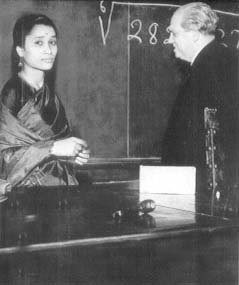
Shakuntala Devi is generally known as a 'Human Computer' because of her extraordinary talents in solving complex mathematical problems without any mechanical aid. She also found her place in the Guinness book of records as a result of her extraordinary talents. Nowadays, apart from solving mathematical problems, she is utilising her amazing talent in the field of astrology.
She was born in 1939 in Bangalore, Karnataka. Manifested with an extraordinary love for numbers at the age of 3, she became an expert in complex mental arithmetic at the age of five. On 18 June 1980, Shakuntala Devi gave the product of two, thirteen digit figures after multiplying them within 28 seconds. Many countries have invited Shakuntala Devi to demonstrate her extraordinary talent. Today, she is acclaimed as an accomplished mathematician.
(Source : www.webindia123.com)

Lata Mangeshkar
(Click on her picture to go to the site 'Lata mangeshkar, a Living Legend')
Born: 28th September, 1929, Indore, Madhya Pradesh, India.
Father: Pt. Dinanath Mangeshkar
Mother: Shudhhamati
Siblings: Meena, Asha, Usha, Hridaynath
First Playback :
1942 - Kitti Haasal(was not used)
1942 - Pahili Mangalagaur (naatli chaitrachi navalai...)
First Hindi song(but in a Marathi Film)
1943 - Gajabhau (maata ek sapoot ki duniya badal de tu...)
First Hindi Film song Playback :
1947 - Aapki Sewa Mein (paa laagu kar jori...)
Films in which young Lata acted:
1942 - Pahili Mangalagaur(within 10 days of her father's demise, she faced the camera to keep the family from starvation)
1943 - Chimukla Sansaar
1943 - Maajhe Baal
1944 - Gajabhau(her performance was highly appreciated)
1945 - Badi Maa
1946 - Jeevan Yaatra
1946 - Subhadra
1948 - Mandir
1952 - Chattrapati Shivaji(only in one song sequence)
Lata composed for the following films, under the pseudonym 'ANANDGHAN':
1950 - Raam Raam Pahune
1962 - Mohityanchi Manjula
1964 - Maratha Tituka Melvava
1965 - Saadhi Maanse
Films produced by Lata Mangeshkar:
1953 - Vaadal (Marathi)
1953 - Jhaanjhar (Hindi, with C.Ramchandran)
1955 - Kanchan (Hindi)
1990 - Lekin (Hindi)
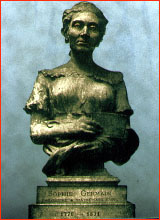
CLICK ON THE PICTURE FOR MORE INFO
SOPHIE GERMAIN
Math's Hidden Woman
Following is the true story of Sophie Germain, an 18th-century woman who assumed a man's identity in order to pursue her passion -- attempting to prove Fermat's Last Theorem.
Sophie Germain was born on April 1, 1776 the daughter of a merchant, Ambroise-Francois Germain. Outside of her work, her life was to be dominated by the turmoil of the French Revolution. The year she discovered her love of numbers, the Bastille was stormed, and her study of calculus was shadowed by the Reign of Terror.
Although her father was financially successful, Sophie's family members were not of the aristocracy. Had she been born into high society, her study of mathematics might have been more acceptable. Although aristocratic women were not actively encouraged to study mathematics, they were expected to have sufficient knowledge of the subject in order to be able to discuss the topic should it arise during polite conversation.
| 
| 
|

